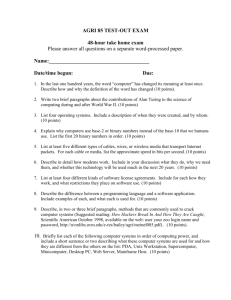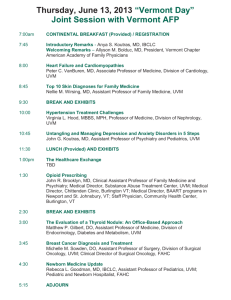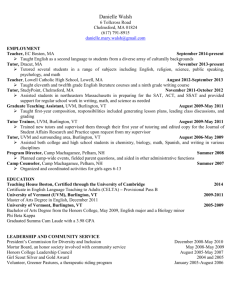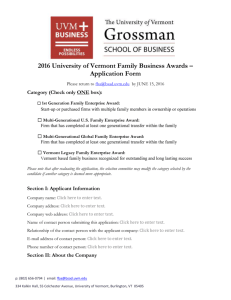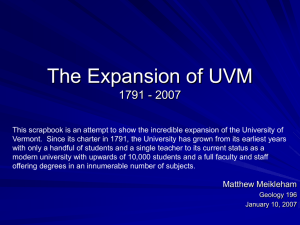CopyofContactInformationforGundProject
advertisement
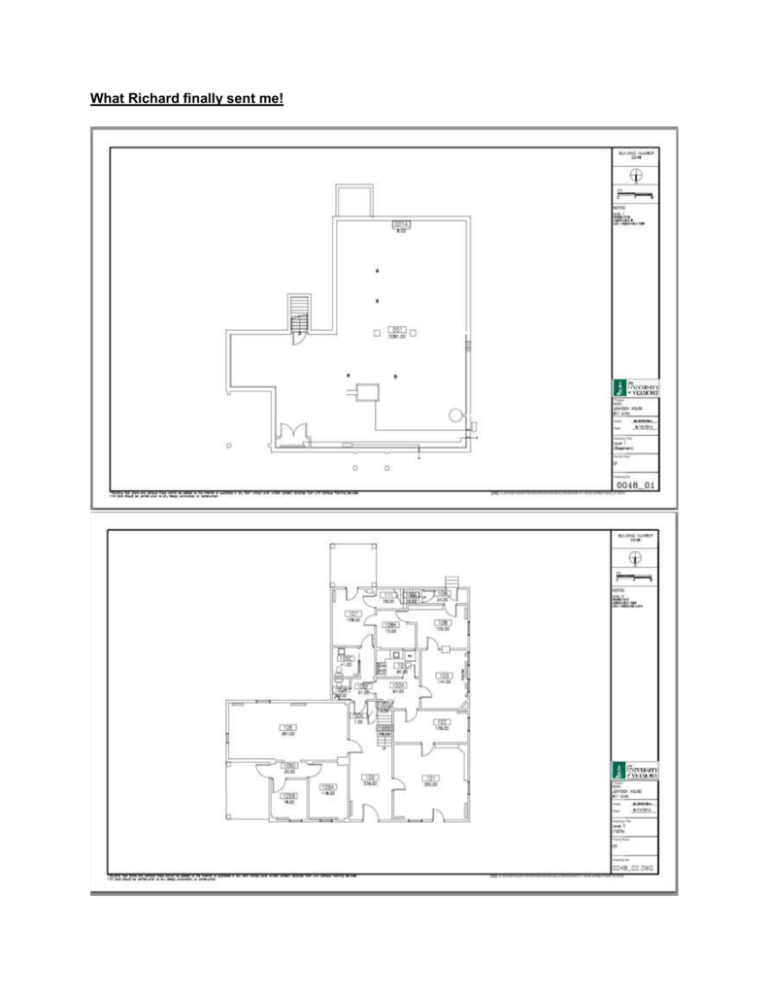
What Richard finally sent me! Wastewater and Runoff City Water, wastewater, stormwater customer service Terri Boylan, Andrea Novotney - (802) 863-4501 Megan Moir, Stormwater manager/coordinator (802)834-9094 mmoir@ci.burlington.vt.us Must complete Stormwater Project Review form for a lot > or = to 400 square feet Stromwater management plan requirements UVM Stormwater Management Director Linda Seavey - Campus planning - 109 South Prospect (802) 656-3208 Must contact for general permit 3-9014, NPDES - also required by VT state Watershed Management Division Planning & Zoning Cty Contact Scott Gustin Senior Planner 802-865-7189 sgustin@burlington.gov Chittenden County Natural Resource Board Stephanie Monaghan (coordinator) 802-879-5562 stephanie.monaghan@state.vt.us Peter Keibel (coordinator) 802-879-5658 peter.keibel@state.vt.us Stormwater Program Megan Moir (suggested contact from Scott Gustin) mmoir@burlingtonvt.gov Chittenden County Regional Planning Commission Department of Public Works 802-863-9094 Fire Prevention Department of Risk Management & Safety- 656-3242- Mary.Dewey@uvm.edu ● Send detailed email to R.M.S ○ give detailed info ○ reason your are doing this project ○ who we are ○ who authorized the project ○ what we lined up ○ what is needed Burlington Fire Department- Assistant Fire Marshall Barry J. Simays (802) 864-6923 ● DO NOT conduct any work prior to consulting a member of different parties ● First people to contact→ UVM Facilities planning ● John Marcus-UVM Fire Marshal (has jurisdiction over building on UVM campus) ○ John.Marcus@uvm.edu ○ (802) 656-8249 ● There is a city process ○ contact Planning & Zoning located at City Hall ○ For Permits→ Building Official, City of Burlington-Ned Holt ● ● ● ● ■ Office located a Department of Public Works ○ Electric Inspector-Shelly Warren ○ Plumbing Mechanical Inspector-John Ryan Permits REQUIRED for any and all work conducted in Burlington As a class, we must follow the process that Burlington has Department of Public Works website contains flow chart which explains the process in further detail State Law/City Ordinance require permit for all work ○ Significant fines apply if not Vermont Division of Fire Safety● Michael Desrochers Division Director (802) 479-7539 ● Robert Patterson: Deputy Director (802) 479-7566 ● Matthew Lindhiem: Fire Safety Building Engineer: (802) 479-7561 Energy Management University of Vermont http://www.uvm.edu/energy/?Page=energyguide.html Burlington http://www.burlingtonvt.gov/uploadedFiles/BurlingtonVTgov/Departments/Legacy_Projec t/About_Us/Legacy%20Action%20Plan.pdf State Level Energy Management --VT Public Service Dept. Energy Efficiency Info: http://publicservice.vermont.gov/topics/energy_efficiency --VT Building Energy Codes: http://www.energycodes.gov/adoption/states/vermont --VT Tax Credits and Incentives for Energy Efficiency: http://www.ecvt.net/ways-to-saveenergy/tax-credits-and-incentives National Level Energy Management --Department of Energy Incentive Guidelines: http://www1.eere.energy.gov/wip/pdfs/state_historic_preservation_programmatic_agreement_vt. pdf --Secretary of the Interior Standards for Rehabilitating Historic Buildings: http://www.wbdg.org/pdfs/secint_stndrehabsustainhb.pdf --Sustainable Historic Preservation LEED Suggestions: http://www.wbdg.org/resources/sustainable_hp.php --Historic Preservation and Solar Panels: http://www.preservationnation.org/informationcenter/sustainable-communities/buildings/solar-panels/additional-resources/NAPC-Solar-PanelGuidelines.pdf ^ Legacy Plan Historical Preservation State and National Level: Contact: James P. Duggan | Historic Preservation Review Coordinator Suggest links about compliance: http://accd.vermont.gov/strong_communities/preservation/review_compliance/rules/22vsa14 http://www.nps.gov/hps/tps/standguide/rehab/rehab_standards.htm http://www.nps.gov/tps/sustainability/new-technology/solar-on-historic.htm http://www.nps.gov/tps/sustainability.htm http://www.uvm.edu/~campus/590main/590mainhistory.html http://www.uvm.edu/histpres/events/johnsonmove.htm Notes from phone discussion: Two Key Things *Most viewed facade is the main determinant in whether things are possible or not* What this means is that the front facade should not have significant changes otherwise most likely it will not meet the standards at the State and National levels. Any addition has to be easily removable and if removed will not damage the building, REVERSIBLE. All new additions to the structure have to meet the Secretary of Interior Standards Section 106 this is all within the National Park Service department, this is on the National Level. On the state level they have to meet Section 22 V.S.A. Chapter 14. National Level though always takes priority. Within Section 106 there are four separate categories in which your project can fit. They are listed on the website but the one most fitting for the Johnson House is Rehabilitation - Adaptive Reuse. The Johnson House is actually already an example of this, initially it was intended for a primary residence but now it is used as an academic building. My questions were in regards to specific things that came up in the meeting with Taylor that I thought James would be able to answer. Gutters - Yes we can have them. They have to be period appropriate but also people should be able to distinguish them as something that was not there 200 years ago. They also have to be easy to remove without damaging the building. Example of a possible gutter would be Copper Half-round gutters. Green roof is maybe doable as long as it is not on a primary roof. Alteration of Grounds - It is specific to the design there are no general standards to follow, he also said it is somewhat lenient. What we need to avoid is a design that does not affect the historic feeling and does not block the most viewed facade. Solar Power - There is a solar incentive, state funding. Roof mounts: flush mounted, maintain same angle of roof, cannot be on the primary front facing roof Ground mounts: Archeology graduate program, ARA can help analyze the grounds as if we were to put supports in the ground, the ground has to be inspected to make sure we are not ruining a future archaeological site. Once again cannot disturb most viewed facade view. Windows - Repair over replacing. Old windows someone local can fix versus with new windows it is more technical. In the case of the Johnson house the only reason for new windows would be if repairing and maintaining an original window would be expensive over time. A new window would also have to comply with the original window facade. To improve efficiency of old windows you can add storm windows which can be approved under Section 106. Allied Storm Windows Inc. makes storms windows that meet the National Park Service requirements. Local Antique Window Specialists: Wanamaker Restoration Jeff Solanger (Williard St. Traditions) Efficiency - Work in the attic and ground floor, walls are harder to work in as you would have to do heavy surgery on the building itself, walls also do not provide as much gain. Dense pack cellulose over blown cellulose as blown leaves residue, tying back into an addition being REVERSIBLE.
